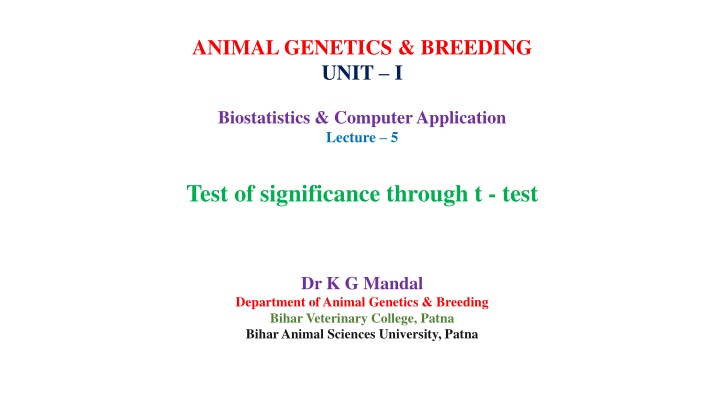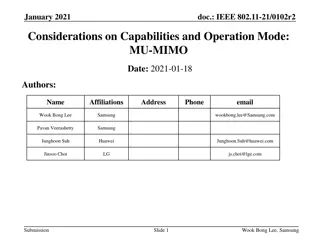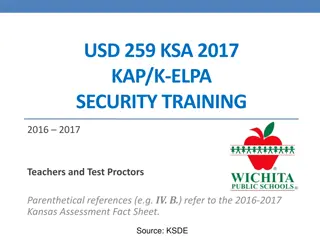
Animal Genetics & Breeding
Learn about t-Test of significance and its application in comparing means in animal genetics and breeding units. Explore the calculation process, types of t-tests, and interpretation of results using a practical example.
Download Presentation

Please find below an Image/Link to download the presentation.
The content on the website is provided AS IS for your information and personal use only. It may not be sold, licensed, or shared on other websites without obtaining consent from the author. If you encounter any issues during the download, it is possible that the publisher has removed the file from their server.
You are allowed to download the files provided on this website for personal or commercial use, subject to the condition that they are used lawfully. All files are the property of their respective owners.
The content on the website is provided AS IS for your information and personal use only. It may not be sold, licensed, or shared on other websites without obtaining consent from the author.
E N D
Presentation Transcript
ANIMAL GENETICS & BREEDING UNIT I Biostatistics & Computer Application Lecture 5 Test of significance through t - test Dr K G Mandal Department of Animal Genetics & Breeding Bihar Veterinary College, Patna Bihar Animal Sciences University, Patna
t test of significance t test is done to find out the significant difference between two means provided the sample size is small (say n = 30 or less). t is the ratio of difference between two means and the standard error of difference between two means. Suppose x = sample mean = population mean Then, t(n-1)df = ? ?2/? = ? ??/ ? = ? ? ??
Where, S2 = sample variance & n = number of observation Thus, t = ?? ?? ??? ?????????? ??????? ??? ????? This test is done to find out whether the sample is true representative of the population or not. Degree of freedom (df) is the same as that of SE. Types of t-test: i. Students t-test ii. Paired t- test iii. Fishers t- test ?????????? ??????? ??? ?????
The concept of t-test was given by W. S. Gosset (1908) 1. Students t-test: W.S. Gosset used his pen name student for publication of his research paper. Student t-test is used to test the equality of a sample mean (x) with the population mean ( ). t(n-1)df = ? ?? As for example: Average daily milk yield of HF crossbred cow in a population of 500 is 15 kg. The average daily milk yield of a sample of 20 HF crossbred cow is 17 kg. It is to be tested whether the sample is true representative of the population or not. ??/? = ? ??/ ? = ? ?
Problem 1. Daily milk production (kg) of 10 goats are observed as follows. The goats were belongs Jamunapari breed whose average production is 3 kg. Does the sample of goats represent the Jamunapari breed. X = 1, 2, 1, 3, 4, 5, 2, 3, 1, 2 = X = 24 X2 = 1, 4, 1, 9, 16, 25, 4, 9, 1, 4 = X2 =74 Solution: Setting up of null hypothesis, Ho: x = HA: x # Calculation of t Sample average, x = 24/10 = 2.4kg Population mean ( ) = 3kg
SE (x) = ?2 74 242/10 9?10 0.42 = 0.6 74 57.6 90 16.4 90 = 0.1822 = 0.42 ? = = = ? ??(?) = 2.4 3 t = Given tabulated value of t for 9df at 0.05 ls = 2.26 Conclusion:- Calculated value of t is not greater than tabulated value t . So, difference between x and is not significant. Hence, HO (null hypothesis) may not be rejected. X = So, sample of goats does represent the Jamunapari breed. 0.42 = 1.42 at 0.01 ls = 3.25
Exercise 1. It is claimed that the average fleece weight per sheep per year of a particular breed is 1654 gms. The following are the records on a sample of 15 sheep. Fleece weight (g): 1134, 896, 1590, 1624, 2123, 2011, 914, 1005, 1603, 1358, 1296, 1480, 989, 1504 and 1818. Does the sample mean agree with the given population mean?
2. To test the equality between means of two samples taken from same population when their variances are also equal. Sample 1. size = n1 , mean = x1 and sample variance = s12 Sample 2. size = n2 , mean = x2 and sample variance = s22 s12 = s22 Setting up of null hypothesis, HO : x1 = x2 Testing Procedure: s12 = ?12 ?1 ?1 1 s22 = ?22 ?2 ?2 1 HA : x1 # x2 2/?1 2/?2
Variances of two samples are to be tested for equality with variance ratio. Variance ratio is denoted F . F = s12 s12 > 1 The variance ratio F is to be verified from the tabulated value of F at (n1 1) and (n2 1) degrees of freedom for its significance. If F is non-significant then we have to follow the following procedure: ?12 ?1 ?1 ?1+?2 2 s22 or s22 2 2/?2 + ?22 ?2 S2 = Combined SE = ?2(1 1 ?1+ ?2)
Then, ?1 ?2 t = ?2(1 ?1+1 ?2) This t is based on n1 + n2 2 df. The calculated value of t is to be verified from the tabulated value of t distribution for n1 + n2 2 df both at 5% and 1% level of significance. If calculated value of t > tabulated value, then it is to be concluded that there is significant difference between means of two samples. And both the samples may not be from the same population. Null hypothesis may not be accepted or rejected.
On the other hand if calculated value of t is < tabulated value then there is no significant difference between two means. Both the samples are taken from the same population. Hence, null hypothesis is accepted or may not be rejected. Exercise 1. From the following records of birth weights of 9 male and 10 female calves find out whether or not the average birth weight is same for both the sexes. Birth wt(kg) of male: 20,19,25,24,26,18,23,25 & 28. Birth wt(kg) of female: 17,16,18,20,22,24,19,25,21 & 18.
Solution: X1 = average birth weight of male. X2 = average birth weight of female. Setting up of null hypothesis, HO : X1 =X2 Alternative hypothesis, HA : X1 # X2






















